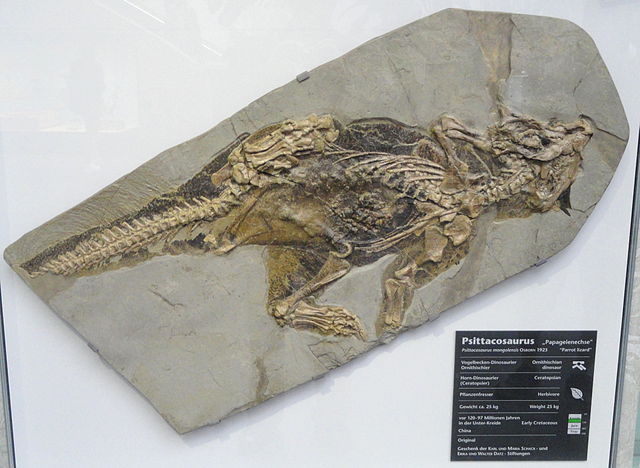
An article published in the journal “Current Biology” describes a research on a dinosaur belonging to the genus Psittacosaurus that lived in modern China at the beginning of the Cretaceous period, about 120 million years ago. A team from the University of Bristol examined the skin remains of a very well preserved specimen cataloged as SMF R 4970 concluding that its coloration provided it some camouflage.
The genus Psittacosaurus is well known thanks to the discovery of many fossils in various parts of Asia. These dinosaurs were related to the famous Triceratops but unlike their cousins were bipeds in their adulthood. Various studies on the various Psittacosaurus species were conducted over the years because the excellent preservation of many fossils revealed not only the characteristics of their skin but in many cases also integument structures that look like goose feathers.
The specimen studied in this research is referred to as Psittacosaurus sp. without a clear assignment to a species because it has not yet been established. The preservation of its skin, covered with normal scales, allowed an analysis of its colors showing a countershading with light-colored shades on its abdomen and dark shades on its back.
Countershading is a useful feature to camouflage and exists today in very different animals as well. It exists in various birds, which are distant cousins of the dinosaurs of the genus Psittacosaurus, part of the order Ornithischia birds descended from. It also exists in other animals such as the white shark, in which the countershading is very pronounced.
This camouflage can be useful to both predators and prey. Psittacosaurus sp. was a herbivore and lived in a time and in an area in which it had to escape predators such as Yutyrannus and Dilong, cousins of T. rex smaller than their more famous relative but still potentially lethal to their prey.
To better study Psittacosaurus sp. the researchers created a full-scale 3D model, meaning the size of golden retriever. Photographing the model in a botanical garden during both sunny and cloudy days, the researchers could see that its countershading camouflaged it better at diffuse light. This suggests that this animal lived in a forest.
Psittacosaurus sp. had a pigmentation which included dark stripes inside its legs, perhaps to keep insects at bay in a manner similar to today’s zebras. The outer area of its front legs had spots that perhaps helped to make its skin tougher thanks to the pigment’s strength.
It’s the first time that paleontologists can find evidence that a dinosaur had camouflage characteristics. The research on Psittacosaurus sp. could show the way for studying camouflage in dinosaurs, which could also help to better understand in what kind of environment a certain species lived.


Permalink